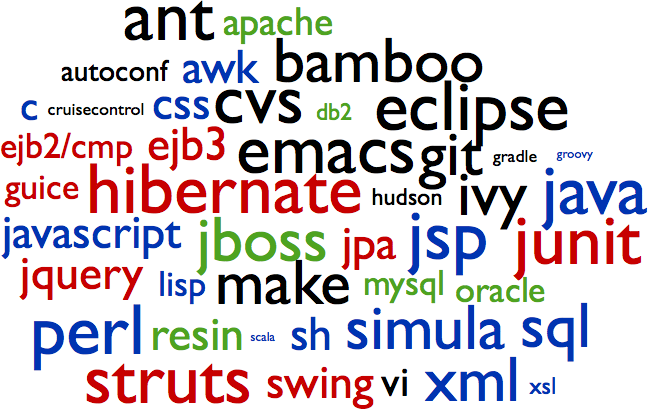The things I love about Clojure and two things that suck
##The things I love
###REPL Working in the REPL is just amazing. It lets you experiment with stuff, redfine functions on the fly, assign stuff to variables, work with them, and it’s just great.
Working in Java, the closest thing I can come to is running unit-tests in your IDE. But still then, it’s just way more complicated.
The REPL, combined with the fact that you normally start out implementing your datastructures in maps and lists, lets you experiment your way through your development.
In Java, you need to figure out what you want to call stuff before you can start working. Is this thing a Person, a Student, or an Employee, and if so, what attributes does it have. In the REPL?
(def p {:name "John"})You need a couple of these?
(def ps [{:name "John"} {:name "Frank"}])Now compare this to the amout of code you’d need to write in Java.
###The way stuff fit together
Take update-in
‘Updates’ a value in a nested associative structure, where ks is a sequence of keys and f is a function that will take the old value and any supplied args and return the new value, and returns a new nested structure. If any levels do not exist, hash-maps will be created.
This lets you write stuff like
(def a-foo {:foo {:bar 2}})
(update-in a-foo [:foo :bar] + 1)
;=> {:foo {:bar 3}}The point here is that the function + is being passed the value of
:bar in :foo along with 1, so you’re actually calling
(+ 2 1)
;=> 3###Sequence abstraction
The sequence abstraction leads to the fact that all the higher-order
functions like map, filter, reduce, etc all work on what ever
kind of collection you throw at them. Even better, if you choose to
start using records with defrecord, they will also work as
sequences!
Along with destructuring, this lets you write stuff like
(defn update-vals
"updates all the values in a map by applying the function f
on them"
[m f]
(map (fn [[k v]] [k (f v)]) m))
(update-vals {:foo 1 :bar 2} inc)
;=> {:foo 2 :bar 3}There are a couple of points to be made of this. First of all it is incredibly concise. My head explodes by just looking at this function.
Secondly it shows that persistent data structures are not that hard to
work with. With functions like update-in and the one above, it’s not
much harder to work with persistent data structures than the, I’d say,
normal, mutable ones you have in Java.
###Emacs I’m so happy to be back in Emacs. I started coding in Emacs again a couple of months ago to see if it was a viable option to Intellij wrt coding in Javascript/Ext.js. I have found it to be so. Given lintnode and projectile, Javascript coding in Emacs works.
But it all comes together in Clojure. You navigate the code with C-M-f and C-M-b, you kill code with C-M-k. And since Clojure is homoiconic (got to use that word), it’s actually quite easy to understand what a s-exp is. It’s the thing in the parens.
Also, Clojure-mode with CIDER just rocks, since it lets you run the REPL inside emacs, which means you don’t ever need to leave.
##The two things that suck So far I’ve only found two things I dislike about Clojure, apart from my brain working on overload trying to remember how my nested data-structures look like
###No debugger
I know there are debugger tools out there, but I do miss the ability
to insert a (debugger) statement in my code and drop into, well, a
debugger which lets me examine the frame I’m in. Right now I’m
resorting to (println), which to me is a huge step backwards.
###Error messages The run-time error messages I get from Clojure are so bad I don’t even want to think about it. It might just be me doing everything wrong, or even having to high expectations, but I just simply want to know the line in my clojure file in which the error occured with some explanation which has some connection to the code I’ve written, not to the Java code which implements Clojure.
##In conclusion The sad bit is that the two points of suckage makes it hard for me to promote Clojure as a language to work in for my colleagues, because along with all the parens (which I look upon as a feature), the lack of debugger and the hopeless errormessages without context, makes Clojure a hard sell.
